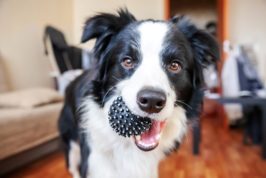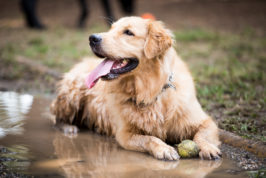Dog breeds prone to obesity
We all want to keep our dogs as healthy as possible, and an important part of that is maintaining a healthy weight. But what if your canine is statistically more likely to gain weight because of its breed?
Certain breeds are actually predisposed to obesity, and if you own one of these, it’s important to be aware of the facts. Dr Hannah Godfrey explores the issue…
Which dog breeds are prone to obesity?
Labrador Retriever
Sadly, it’s become commonplace to see overweight Labradors, and they have the highest obesity rate of all dog breeds. Their appetite can seem infinite, so weighing out their food allowance and restricting treats is really important. Research suggests that the reason for their insatiable appetite is a potential mutation in the genes that recognise body fat and ‘switch off’ hunger after a meal.

Golden Retriever
Similar to Labradors, overweight Golden Retrievers have become very common. In the US, over 60% of Golden Retrievers are overweight, and the figure is likely to be similar in the UK. The same genetic mutation has been suggested as a possible cause, and another study suggested the breed is particularly prone to weight gain after neutering. Therefore, ensuring your dog is a healthy weight before neutering and offering a lighter diet afterwards would be recommended.
Cocker Spaniel
Cocker Spaniels are a lively, high-energy breed, so if their exercise needs are not met, their weight can creep up. They’re also prone to Hypothyroidism, where an underactive thyroid gland causes their metabolism to slow and their energy levels to reduce.
Cavalier King Charles Spaniel
Cavaliers are real lap dogs and enjoy a cuddle. If they’re allowed to lead a sedentary lifestyle they tend to gain weight. They’re also prone to Heart Disease and brachycephalic airway obstruction, which can reduce their ability to exercise, leading to weight gain.
Rottweiler
Like Cocker Spaniels, Rottweilers are prone to Hypothyroidism. As a large breed with lots of energy, these dogs also tend to get fat if their exercise regime is insufficient.
Dalmatian
Another breed with a large appetite, Dalmatians are also adept at begging. Avoiding too many treats and titbits will help to keep their weight in check.

Shetland Sheepdog
Shelties are a naturally active breed, but if they’re not given the opportunity to exercise, they will need a reduced diet to prevent weight gain.
Dachshund
Dachshunds are not necessarily built for speed, and their short legs and long body – as well as their tendency for spine problems – mean that their exercise should be controlled. Therefore, they may need a stricter diet to keep their weight healthy.
It’s not just pedigree breeds that are predisposed to obesity. Crossbreeds are also prone to gaining excessive extra pounds!
Health consequences of obesity
An obese dog is at greater risk of many health conditions, due to increased strain on the joints and organs of the body. Some of these conditions include Arthritis, Cruciate Ligament Disease, and Heart Disease. Diabetes is also more common in obese dogs, due to the increased insulin demand on the pancreas.
Health conditions are not just a consequence of obesity, they can also be a cause. For example, if your dog has slowed down recently, seems stiffer, or has less enthusiasm for exercise, it could be a sign that they have Arthritis. Equally, if they seem more breathless or lethargic, there could be another illness causing their lack of exercise tolerance.
My dog is predisposed, what can I do?
If your dog is predisposed to obesity, that isn’t a guarantee that they’ll become overweight, just that they are more likely to. Knowing that your dog may struggle with their weight can be useful, as it means you can keep a closer eye on their diet and exercise regime. It also means you can watch out for signs of Arthritis, an underactive thyroid gland, Heart Disease, or any other condition that might affect their ability to exercise.
Monitoring your dog’s weight
Keeping tabs on your dog’s weight will help you spot any changes early. A visit to your vet will allow you to discuss your dog’s ideal weight, as well as any diet and exercise advice. Your vet might work out your dog’s Body Condition Score, which is a measurement that takes into account the amount of fat in various places on your dog’s body, and results in a score from one to nine. A score of one would mean a dog is emaciated, whereas a score of nine would be morbidly obese. Your vet may also offer a weight clinic, or at least allow regular use of their weighing scales to support you in your efforts to keep your beloved pet trim!
It can be helpful to familiarise yourself with your dog’s body shape, by using your hands to feel the areas that are used to formulate the Body Condition Score. By running your hands along your dog’s spine and ribs, you can feel how prominent the bones are, or how much fatty ‘padding’ they have. If you perform this check regularly you may be able to spot weight gain fast.
Conclusion
Speak to a vet if you need support or have concerns that your dog might be suffering from a condition that impacts their weight and mobility. They will be able to perform tests, x-rays, or recommend medications like joint supplements or pain relief to keep your dog moving and their weight in check.




